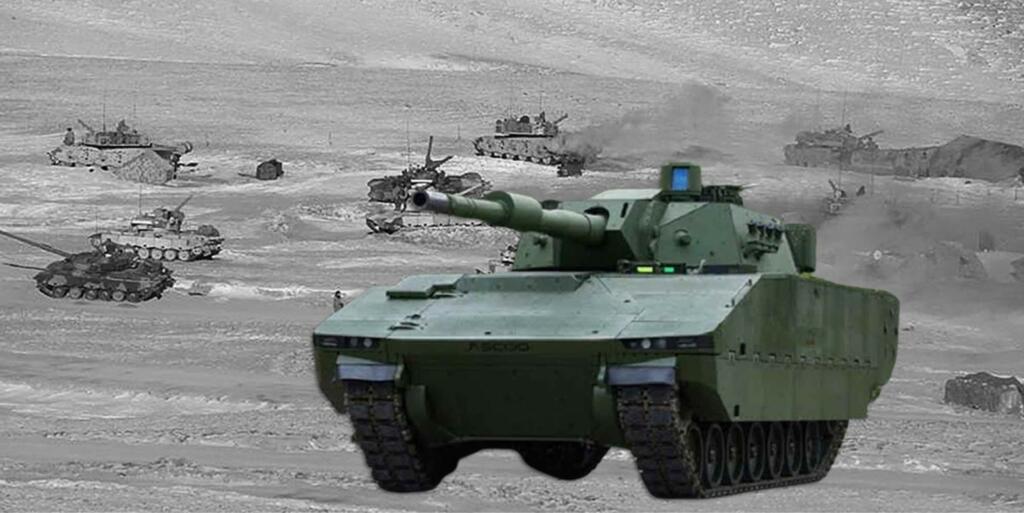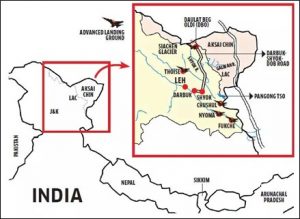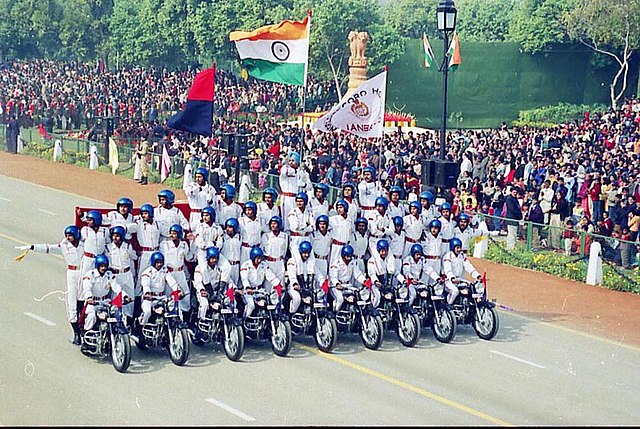
‘Project Zorawar’ Light Tank: A New Sentinel For India’s High-Altitude Borders!

Image Source: TFIPost
As is true for most modernisation projects in Defence Forces the world over, the Indian Army’s proposal for acquisition of Light Tanks was catalysed by the dynamics of the stand-off with the People’s’ Liberation Army (PLA) of China in Eastern Ladakh- itself a bleak, wind-swept, high-altitude region of barren expanse broken by sheer heights with large territorial gaps. An ideal terrain for exploitation by lightweight and powerful Armoured Fighting Vehicles, capable of being brought into the sector/ as reinforcements at short notice via the ground route or aboard strategic aerial mobility carriers!
Apropos, the Indian Army’s Directorate General of Mechanised Forces, had on 22 April 2021, issued a Request for Information (RFI) in the domestic and international market for procurement of 354 Light Tank (Tracked) for the Indian Army (IA), as a new generation combat vehicle platform!
What is the Overbearing Requirement of a Light Tank for the Indian Army?

Source: drishtiias.com
The 4057 Km long Line of Actual Control (LAC) with China (estimates may vary) is characterised by variegated terrain to include mountain ridges interspersed with passes, river valleys, and wide-open plains. The outcome of any tactical altercation along the LAC will be determined by the responsiveness of either adversary in what is classically termed as a ‘race for the passes’, with the intent to dominate the surrounding terrain from the watershed(s) on which such passes exist. Such tactical operations would be preceded/ accompanied by Artillery bombardment to soften the adversary/ weaken his resolve. Ab-initio involvement of aerial resources across the LAC is unlikely, given the initial politico-military dispensations involved and is therefore not discussed further here. The region on the Indian side is also interspersed with several strategically important projects / locations, including the Advanced Landing Ground (ALG) at Daulat Beg Oldie (DBO), the 255 Km long DBO- Shyok Road, the Western portion of the Depsang Plains to the North, the Chushul Valley (scene of a major Sino-Indian battle in 1962) and the Southern banks of the Pangong-Tso Lake, to name a few. The 2020 Galwan Valley clashes were sparked off by China’s objection to the DBO-Shyok Road, which also has minor alignments leading to the former. It was later learnt that the PLA’s Western Theatre Command had deployed elements of its Motorised/ Mechanised Divisions, which included the ZTQ-15 Light Tanks. It was noted then with consternation that these light and agile platforms could out-manoeuvre and deploy/ re-deploy ahead of the Indian Army’s (IA) heavier and less mobile T-72 and T-90 Main Battle Tanks (MBTs). Added to this was the relatively lower power-to-weight ratio of these MBTs (a result of requirements of heavier armour/ enhanced armament for tank vs tank engagements in the plains) and logistics burden involved in specifically catering for operation of these MBTs in such high-altitude areas. In addition to these regions along the LAC, there exist numerous locations along the 776 Km long Line of Control (LC) with Pakistan, both within/ outside the Kashmir Valley and across the Zojila Pass similar to the LAC. Light Tanks could provide specific advantages of quicker response, manoeuvre, enhanced firepower and protection for prosecution of operations in such areas too.
Historically, it is also pertinent to mention that India had, in 1962, successfully deployed the French AMX-13 Light Tanks against China in the regions of Chushul and Bomdila. The British Stuart Light Tank also met with tremendous success in the Battle of Zojila against Pakistan in 1948. Unfortunately, the concept of the Light Tanks did not find favour within the paradigm of massed armour assaults by heavier MBTs envisaged against Pakistan in the 1970s/80s, since the latter represented the more immediate threat at the time. This led to these versatile and potent machines being phased out from the IA. An interim RFI was reportedly floated in 2009 for a Light Tank, but abandoned due to the requirement of financial resources for other MBT acquisitions/ projects.
Apropos the above, the IA concluded that the Light Tanks posed several advantages in such terrain, including greater fuel efficiency (larger combat radius and turnaround)- allowing for protracted, sustained operations in remote areas. Its ability to operate closer to the LAC/LC and passes therein in mountainous terrain enables providing close support to the Infantry/ denying such areas to the adversary, employability in weapon emplacements in positions of vantage overlooking lower reaches, manoeuvering in order to outflank enemy Infantry/mechanised elements, adaptability for swift air induction into remote areas to the beat the adversary in space/ time. Employability in severing the adversary’s logistics supply chains, which are tenuous at best in such remote regions is another payoff.
Specifications of the Project
The proposal envisages the development of a Light Tank as a ‘multiple weapons platform’ along with the infusion of niche technology for peak performance and enhanced mobility in high-altitude areas, including in marginal terrain. The facets of the platform would include Artificial Intelligence driven functionality, all-terrain agility, multi-layered protection, lethal firepower and real-time situational awareness. The numbers requisitioned would be adequate to equip 6-7 full-scale Regiments for employment in such areas along the LAC with China, while retaining the flexibility for employment against Pakistan as well, should the operational scenario necessitate.
The envisaged major operational parameters of the Light Tanks are al elucidated in the table below:-

Notes.
*- This would obviate the need to mount a separate external ATGM launcher.
#- Rolled Homogenous Armour.
&- Stipulates the protection equivalent to the stated thickness of RHA.
^- NATO Standardization Agreement covering the standards for protection levels for occupants of logistic and light-armoured vehicles. STANAG Level 3 would refer to protection against Armour Piercing Bullets with velocity of 930 m/sec at 30 m range, against grenade/mine blast with upto 8 Kg explosive mass and against a 155m High Explosive Artillery shell at 60 m.
$- Implies a higher Power-Weight Ratio compared to the Chinese Type-15 Light Tanks in operational configuration, deployed against own forces in Eastern Ladakh.
@- Refer to radios that rely on digital algorithms instead of analogous circuits for functioning, thus enjoying higher imperviousness to jamming.
Present Status of ‘Project Zorawar’
Given the prevailing operational imperatives along the LAC, and the urgency to enhance own operational efficiency therein, the IA in the interim also considered acquisition of the Russian Sprut SDM1 Light Tank. The shortlisting of this Russian Light Tank is likely to have been influenced by the fact that the Sprut shares the same 125 mm smooth-bore main gun and ammunition profile with the IA’s in-service T-72 and T-90 MBTs, thus lightening the logistics/ maintenance burden, should the Light Tank have been similarly deployed. This venture unfortunately failed to materialise because of a few reasons- firstly, it soon became evident that the SDM1 was more of a mobile anti-tank platform and lacked certain key requisites for classification as an archetypal Armoured Fighting Vehicle and secondly, the ongoing Russia-Ukraine War had adversely impacted the sustainment of the IA’s existing MBT fleet, thereby imposing caution against an ex-import acquisition.
It has also been reported that the South Korean firm, Hanwha Defence, had prepared to offer the IA its K21-105 Light Tank. This tank sports a 105mm main gun and can engage targets from an elevation of 42 degrees to 10 degrees of depression, thus suggesting versatility of employment in mountainous terrain (read more @ https://chanakyaforum.com/k21-105-light-tank-solution-from-hanwha/ ).
It was then decided to go ahead with the development of an indigenous platform by the Combat Vehicles Research & Development Establishment (CVRDE) of the DRDO, in collaboration with a Development Agency (DA) under the Development cum Production Partner (DCPP) model of the Defence Acquisition Procedure (DAP)-2020.
Subsequently, post floating of RFI in April 2021, the project was accorded ‘Approval in Principle’, to be progressed under the Make-I Category of DAP 2020, wherein the Government would fund upto 70% of prototype development cost or a maximum of ₹250 crores per DA (the upper ceiling of such funding would, however, depend on the progress of the project and the funds sought by the DA). This would translate into acquisition through the Buy Indian (IDDM [Indigenously Designed, Developed and Manufactured]) route with minimum of 50% indigenous content, in keeping with India’s ethos of achieving Atmanirbharta in the Defence Sector, among others.
The General Staff Qualitative Requirements were finalised in September 2022 for further grant of Acceptance of Necessity (AoN) for the Project. Concurrently, Larsen & Toubro (manufacturers of the K9 Vajra Self-Propelled Artillery Tracked Gun System) have been selected as the DA and Lead System Integrator for development of the Light Tank in collaboration with DRDO. In a testimony to the alacrity being accorded to the Project, DRDO unveiled a scaled model of the Light Tank at DefExpo 22, held in October 22 in Gandhinagar, Gujarat! The AoN for approximately INR16000 Crores for the Light Tank was finally accorded in December 2022, post which the Request for Proposal (RFP) is going to be issued.

Scaled Model of Zorawar LT at DefExpo22:Source-twitter.com
The first DRDO-Larsen & Toubro developed prototype is expected to be fielded for technical trials late this year, following which the IA will undertake user trials. The timely fielding of the prototype could result in DRDO bagging the contract to manufacture 59 (~ one Regiment) of the 354 Light Tanks, the rest being manufactured under an Indian Government funded Design& Development Project in the Make-I Category of DAP-2020. The prototype would feature an indigenous hull developed jointly by CVRDE and Larsen & Toubro, with a 105 mm main gun turret, procured from Belgian firm, John Cockerill, who specialise in gun systems ranging from 20 to 105 mm calibre. The power pack is likely to be an 800-1000 HP water-cooled V8 high-altitude optimised engine manufactured by German Firm, MTU Aero Engines, a Rolls-Royce subsidiary.
It has also likely that other vendors from the Defence industry could enter the fray for this capital project in competition with DRDO.
Conclusion
The development of Light Tanks for deployment by the IA in high-altitude/ remote areas opposite China and if necessary, Pakistan would definitely prove to be a deterrent against any misadventures by an adversary across the LAC/LC and a potent force multiplier should battle be enjoined in these remote regions. The notion of universal employability across the Indian subcontinent will continue to remain a point of debate as the IA ruminates over the advantages of tailor-made equipment to suit specific operational requirements versus the advantages of a ‘one-size-fits-all’ design.
Disclaimer
The opinions expressed in this article are the author’s own and do not reflect the views of Chanakya Forum. All information provided in this article including timeliness, completeness, accuracy, suitability or validity of information referenced therein, is the sole responsibility of the author. www.chanakyaforum.com does not assume any responsibility for the same.
Chanakya Forum is now on . Click here to join our channel (@ChanakyaForum) and stay updated with the latest headlines and articles.
Important
We work round the clock to bring you the finest articles and updates from around the world. There is a team that works tirelessly to ensure that you have a seamless reading experience. But all this costs money. Please support us so that we keep doing what we do best. Happy Reading
Support Us















POST COMMENTS (1)
Gurpreet Singh